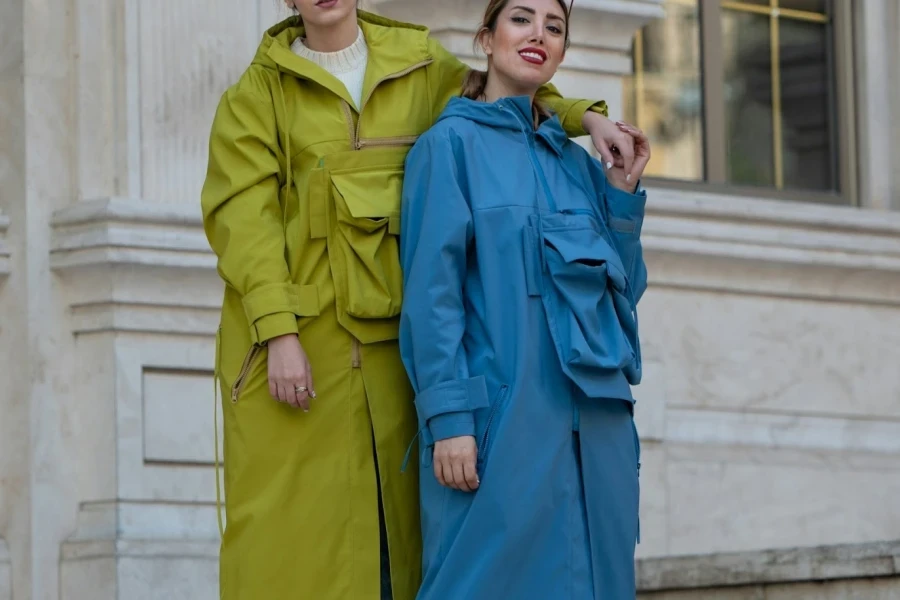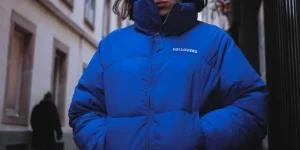Spending time outdoors is a fun activity for many modern consumers. But even though the summer/spring weather is not as harsh as winter, outdoor enthusiasts must still protect themselves from various elements. And two of the top choices include windbreakers and rain jackets.
Both outdoor jackets do different things exceptionally well. But don’t be fooled by their names. Rain jackets can do more than provide rain protection, while windbreakers are not just for the wind. This windbreaker vs. rain jacket comparison guide will help explore these differences and see which option is attracting more attention in 2024.
Table of Contents
A brief look at the outerwear market in 2024
Windbreakers vs. rain jackets: Key differences businesses should note
Windbreakers vs. rain jackets: Which one is more popular?
Wrapping up
A brief look at the outerwear market in 2024
According to GM Insights, the outerwear market rounded up in 2023 with an impressive US$ 35 billion value. The report suggests the market will keep growing at a 6.6% compound annual growth rate (CAGR) from 2024 to 2032. More importantly, the outerwear market owes its growth to the rising interest in outdoor activities like hiking and camping.
The same report states that the topwear segment generated the most sales in 2023, pushing its value to US$ 19.6 billion. North America is also the dominant region in the outerwear market, hogging up to 40% of total revenue share.
Windbreakers vs. rain jackets: Key differences businesses should note
1. Water resistance

Most outdoor jackets tend to have water resistance—although some do it better. For instance, windbreakers are not waterproof. Instead, they offer enough resistance to keep wearers dry from light rain or mist. This is why they shine more in windy environments over heavy downpours.
On the other hand, rain jackets have completely waterproof designs. Manufacturers make them from tightly woven materials (like nylon or Gore-Tex) to protect consumers against heavy rain. Some versions without these fabrics come with water repellents (DWR) to keep water from the wearer.
2. Breathability
Windbreakers are widely used for their extreme breathability. Manufacturers make them from lightweight, loose-weave fabrics like polyester. But that’s not all. These fabrics often have mesh panels that give them the much-loved ventilation. Hence, windbreakers allow sweat to escape easily, keeping wearers comfortable regardless of the activity.
In contrast, a rain jacket’s breathability depends on its design. Consumers who want high breathability will use rain jackets featuring advanced membranes. These jackets balance breathability with waterproofing, making them suitable for sweaty activities—but at a higher cost.
Some models are more affordable but at the cost of being less breathable. Typically, these rain jackets prioritize waterproofing over breathability, making them ideal for short bursts of rain. Anything more than that, consumers will be super uncomfortable and clammy.
3. Comfort and wear

Knowing the elements consumers intend to conquer helps them determine which outdoor jacket to choose. Remember, windbreakers and rain jackets excel at different things, but that’s not all that makes them comfortable in their elements.
For starters, windbreakers will always be the top choice when comfort and breathability are more critical than water protection. In addition to wind resistance, their fabrics have quiet profiles, making them perfect for hiking or wildlife photography, where silence is a significant advantage. Windbreakers also have more athletic fits that help increase their wind protection.
Contrarily, rain jackets tend to be stiffer than windbreakers to provide superior waterproofing. However, this can come at the cost of comfort (most times). To counter this, manufacturers make them with loose fits, allowing consumers to layer comfy clothes underneath (especially during winter).
4. Weight and packability
Since windbreakers feature thinner fabrics, they are incredibly light and packable. This lightweight design gives them better mobility, as consumers won’t feel restricted with them layered over a base layer. The best part? Consumers can fold them for easy storage in backpacks or purses.
On the other hand, rain jackets are heavier due to their multiple layers. While they are less flexible and mobile, rain jackets offer superior protection. Unfortunately, their bulkier designs mean they won’t pack down easily, making them less convenient for carrying around.
5. Warmth
Windbreakers excel at all things wind, so they are the perfect jackets for keeping wearers away from windchill. However, they offer minimal warmth for everything else, making them less effective for cold weather.
In contrast, rain jackets can go beyond waterproofing to keep consumers warm in the chilly rain. Some models come with additional insulating layers (fleece or down) to make them extra cozy in cold and wet conditions.
6. Durability
Windbreakers are not weak but can’t handle extreme conditions like rain jackets. While they can resist damage from wind, their lighter fabrics may be weak to rips and tears from everyday wear.
Rain jackets don’t have this weakness. They are generally more durable and can handle anything from harsh weather conditions. Rain jackets are highly durable thanks to their thicker fabrics and multiple layers. However, their waterproof membrane may lose effectiveness over time.
7. Seasons

Windbreakers and rain jackets have their perfect seasons. For example, windbreakers excel in spring, summer, and fall. Their designs make them great for those cool, windy days or light rain showers.
But rain jackets are way more versatile. In truth, consumers can wear them year-round, depending on the jacket’s features. But they shine more in wet and cold weather or unexpected downpours.
8. Activity
What consumers want to do influences their jacket choice. However, it also depends on the weather conditions they may experience on their activity day. Here are several popular activities for more insight.
| Activity | Recommended jackets |
| Trail running | Customers interested in this activity will want lightweight rain jackets for days with forecasted heavy downpours. However, they will go for windbreakers on sunny days. |
| Hiking | Sometimes, the weather will be unpredictable during hiking adventures. Hence, hikers may go for comfy rain jackets with lots of pockets. But milder weather conditions won’t need anything more than windbreakers. |
| Fishing | Would consumers be fishing in wet weather? They will need solid rain jackets to keep them dry and comfy. But windbreakers offer better sun and excellent breeze protection on sunny fishing days. |
9. Layering possibilities
Despite being lightweight, windbreakers are not very good for layering. Their tighter fits make it very uncomfortable to layer bulky clothing. Instead, they can handle single layering, so consumers will only use them for mild weather.
As mentioned earlier, manufacturers make rain jackets with more spacious designs. For this reason, consumers can pull off any layering look they want. This benefit also makes rain jackets ideal for various temperatures.
10. Fashion and style

Windbreakers and rain jackets offer their unique aesthetics. Windbreakers have sportier vibes, allowing consumers to rock them for casual outfits or athletic activities. They may also come with trendy hues and eye-catching patterns.
On the other hand, rain jackets appeal to those looking for sleeker and more functional aesthetics. They pair beautifully with urban wardrobes and outdoor adventure gear. Plus, consumers can get them in different styles and colors.
Windbreakers vs. rain jackets: Which one is more popular?

Choosing between windbreakers and rain jackets depends on the target consumer’s needs and typical weather conditions. If they want protection against wind and mild rain (and want to keep things lightweight), windbreakers are what they are looking for. But if they frequently face wet environments or heavy rain, rain jackets will come in handy.
Moving on to the most critical question: which one is more popular? According to Google ads, windbreakers experienced a search boom in three months, jumping from 550,000 searches to 1.2 million (In May), 1.5 million (in June), and 1 million (in July) in 2024.
In contrast, rain jackets attract fewer searches. Research shows they consistently rake in 165,000 searches monthly in 2024. Based on these stats, more consumers are searching for windbreakers for their outdoor adventures.
Wrapping up
The debate between windbreakers and rain jackets is a long-standing one. However, windbreakers are the winners in 2024, as more people are searching for them. Nevertheless, rain jackets are still profitable enough for businesses to add to their inventories.
Although rain jackets may not be as popular as windbreakers, they still attract hundreds of thousands of searches. Retailers can diversify their inventories by selling both outdoor jackets. However, if business buyers decide on their next move based on popularity, windbreakers are a sure bet in 2024.




